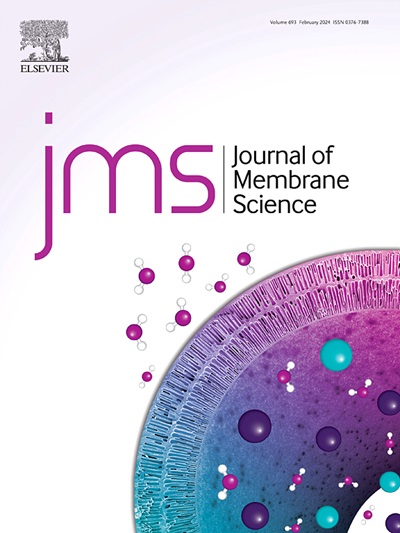Interfacial polymerization of poly(quaternary ammonium) membranes with extreme acid stability for phosphorus recovery from phosphogypsum leachate
IF 8.4
1区 工程技术
Q1 ENGINEERING, CHEMICAL
引用次数: 0
Abstract
Phosphogypsum leachate, a phosphorus-rich wastewater, poses significant threats to aquatic ecosystems. Nanofiltration represents a promising approach for phosphorus recovery from such leachate by selectively allowing phosphorus permeation while rejecting multivalent cations. However, the widespread application of conventional polyamide nanofiltration membranes in phosphogypsum leachate treatment is constrained by their poor acid stability. Herein, To address this limitation, an acid-resistant, highly positively charged nanofiltration membrane was fabricated by synthesizing a crosslinked poly(quaternary ammonium) selective layer on a polysulfone support via a temperature-regulated interfacial polymerization between N,N,N′,N″,N″-pentamethyldiethylenetriamine (PMDTA) and 1,3,5-Tris(bromomethyl)benzene (TBB). Remarkably, elevating reaction temperature not only enables the formation of an ultrathin selective layer (30 nm) with dense cross-linking (MWCO = 471 Da) but also achieves rapid synthesis within 2 min. The poly(quaternary ammonium) membranes achieved a high MgCl2 rejection (97.17 %) and a high P permeation (88.16 %) owing to the exceptionally strong positive charge provided by quaternary ammonium groups. Moreover, the “C–N+” bonds within the poly(quaternary ammonium) structure contribute to exceptional acid stability. The membranes remain stable after prolonged immersion in 1.5 M H2SO4 for 40 days (MgCl2 rejection >95 %). This breakthrough combination of ultrafast reaction, high cation selectivity and outstanding acid stability positions the poly(quaternary ammonium) membrane as a highly viable candidate for phosphogypsum leachate treatment applications.

极酸稳定性聚季铵膜的界面聚合用于磷石膏渗滤液中磷的回收
磷石膏渗滤液是一种富磷废水,对水生生态系统构成重大威胁。纳滤是一种很有前途的方法,通过选择性地允许磷渗透,同时拒绝多价阳离子,从这种渗滤液中回收磷。然而,传统聚酰胺纳滤膜在磷石膏渗滤液处理中的广泛应用受到其酸稳定性差的限制。为了解决这一限制,通过在N,N,N ',N″,N″-五甲基二乙基三胺(PMDTA)和1,3,5-三(溴乙基)苯(TBB)之间进行温度调节的界面聚合,在聚砜载体上合成交联聚(季铵)选择层,制备了耐酸、高正电荷的纳滤膜。值得注意的是,提高反应温度不仅可以形成一个超薄的选择层(30 nm),具有密集的交联(MWCO = 471 Da),而且可以在2分钟内快速合成。由于季铵基团提供了异常强的正电荷,聚季铵膜具有高的MgCl2截除率(97.17%)和高的P渗透率(88.16%)。此外,聚季铵结构中的“C-N +”键有助于优异的酸稳定性。在1.5 M H2SO4中长时间浸泡40天后,膜保持稳定(MgCl2去除率95%)。这种超快反应、高阳离子选择性和优异的酸稳定性的突破性组合使聚季铵膜成为磷石膏渗滤液处理应用的高度可行的候选者。
本文章由计算机程序翻译,如有差异,请以英文原文为准。
求助全文
约1分钟内获得全文
求助全文
来源期刊

Journal of Membrane Science
工程技术-高分子科学
CiteScore
17.10
自引率
17.90%
发文量
1031
审稿时长
2.5 months
期刊介绍:
The Journal of Membrane Science is a publication that focuses on membrane systems and is aimed at academic and industrial chemists, chemical engineers, materials scientists, and membranologists. It publishes original research and reviews on various aspects of membrane transport, membrane formation/structure, fouling, module/process design, and processes/applications. The journal primarily focuses on the structure, function, and performance of non-biological membranes but also includes papers that relate to biological membranes. The Journal of Membrane Science publishes Full Text Papers, State-of-the-Art Reviews, Letters to the Editor, and Perspectives.
 求助内容:
求助内容: 应助结果提醒方式:
应助结果提醒方式:


